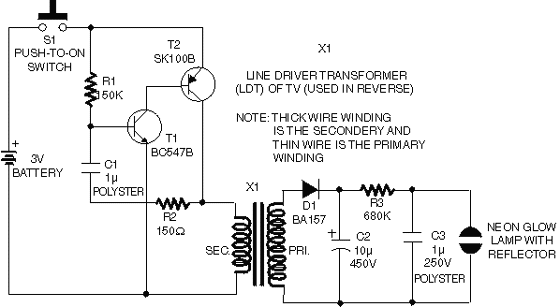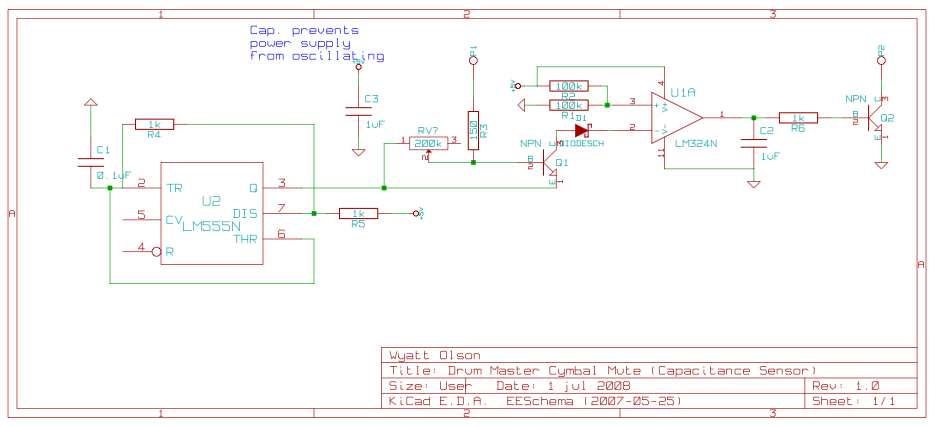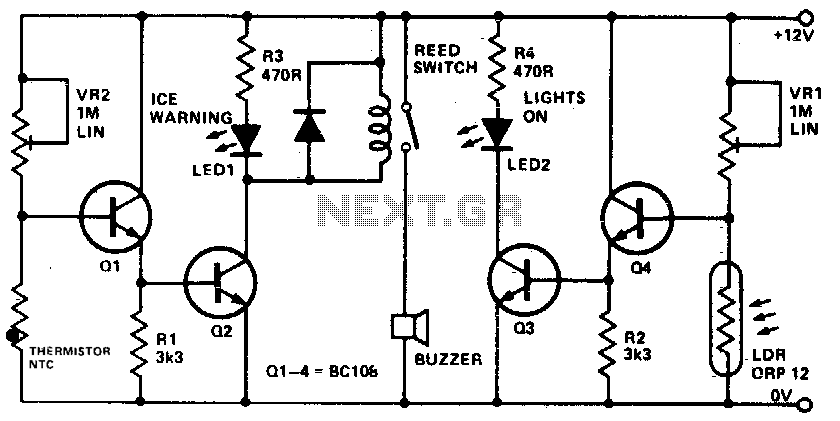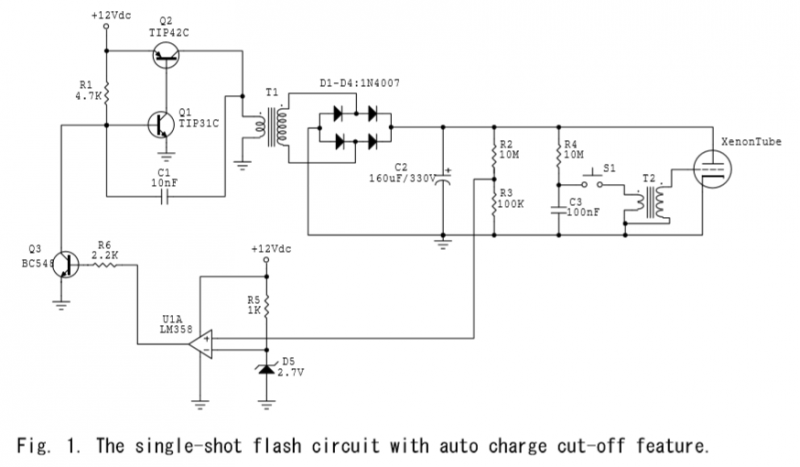
Strobe Flash Light Circuits

This circuit operates on 12V DC instead of mains AC. This is an advantageous approach for those who prefer not to deal with circuits connected directly to mains voltage or wish to power the stroboscope using batteries. Flash Slave Trigger: Flash slaves are utilized when additional flash units are required to supplement a primary flash unit. This slave trigger activates those additional units. It achieves this by detecting the initial flash (via a phototransistor) and triggering the subsequent flashes a few microseconds later. The circuit's sensitivity can be adjusted to accommodate ambient light conditions or to respond to master flashes that are dimmer than usual. Hacking the Kodak Max Single Flash Camera into a Self-Repeating Strobe: This method is primarily suggested for DIY enthusiasts looking to create a strobe powered by a single 1.5-volt battery. If a higher supply voltage is available, more effective methods exist. The brightness of the LED can be controlled at various frequencies through duty-cycle and pulse width modulation. This capability is beneficial for measuring motor speeds and can be easily calibrated using a watch, eliminating the need for a frequency counter.
This circuit design provides a practical solution for those interested in creating a battery-operated stroboscope while minimizing the risks associated with mains voltage. The use of 12V DC allows for safer operation and greater flexibility in application, especially in portable setups. The Flash Slave Trigger component enhances the versatility of the stroboscope by enabling the simultaneous operation of multiple flash units. This is particularly useful in photography and other lighting applications where additional light sources are required to achieve the desired exposure or effect.
The phototransistor serves as a critical component in the flash slave trigger circuit. It detects the light emitted by the primary flash and initiates the triggering sequence for the additional flashes. The design includes an adjustable sensitivity feature, allowing users to fine-tune the circuit's responsiveness to varying lighting conditions. This is essential in scenarios where the primary flash may not be sufficiently bright or when ambient light interferes with the detection process.
For those interested in modifying a Kodak Max Single Flash Camera, the self-repeating strobe approach offers an innovative way to repurpose existing hardware. By utilizing a single 1.5-volt battery, this method allows for a compact and efficient strobe solution. However, it is important to note that higher voltage options can yield improved performance and efficiency.
The control of LED brightness through duty-cycle and pulse width modulation is a significant feature of this circuit. This capability not only enhances the strobe's functionality but also provides a means for precise measurement of motor speeds. The ability to calibrate the system using a standard watch simplifies the process for users, making it accessible even for those without specialized equipment. Overall, this circuit design represents a blend of safety, versatility, and practicality, suitable for a range of applications in both photography and electronics experimentation.This circuit uses12V DC instead od mains AC. This is very good idea if you don`t want to mess with direct mains voltage connected circuit or you want to run the stroboscope from batteries. Flash Slave Trigger : Flash slaves are used when you need to supplement1-flash unit with1-or several more.
This slave trigger simply triggers those other units. It does this by "seeing" the first flash (using a phototransistor) and triggering the other flashes a few microseconds later. The sensitivity of the circuit is adjustable to compensate for ambient light or dimmer than usual master flashes.
Hacking the Kodak Max Single Flash Camera Into a Self Repeating Strobe : this approach is recommended mainly for home brewing a strobe that is powered by a single1. 5 volt battery. If you can use a higher supply voltage, there are better ways to do this. brightness of the LED at all frequencies. This is accomplished by duty-cycle and pulse width control. It is useful for measuring the speed of motors. It can easily be calibrated using a watch so you don`t need a frequency counter. 🔗 External reference
This circuit design provides a practical solution for those interested in creating a battery-operated stroboscope while minimizing the risks associated with mains voltage. The use of 12V DC allows for safer operation and greater flexibility in application, especially in portable setups. The Flash Slave Trigger component enhances the versatility of the stroboscope by enabling the simultaneous operation of multiple flash units. This is particularly useful in photography and other lighting applications where additional light sources are required to achieve the desired exposure or effect.
The phototransistor serves as a critical component in the flash slave trigger circuit. It detects the light emitted by the primary flash and initiates the triggering sequence for the additional flashes. The design includes an adjustable sensitivity feature, allowing users to fine-tune the circuit's responsiveness to varying lighting conditions. This is essential in scenarios where the primary flash may not be sufficiently bright or when ambient light interferes with the detection process.
For those interested in modifying a Kodak Max Single Flash Camera, the self-repeating strobe approach offers an innovative way to repurpose existing hardware. By utilizing a single 1.5-volt battery, this method allows for a compact and efficient strobe solution. However, it is important to note that higher voltage options can yield improved performance and efficiency.
The control of LED brightness through duty-cycle and pulse width modulation is a significant feature of this circuit. This capability not only enhances the strobe's functionality but also provides a means for precise measurement of motor speeds. The ability to calibrate the system using a standard watch simplifies the process for users, making it accessible even for those without specialized equipment. Overall, this circuit design represents a blend of safety, versatility, and practicality, suitable for a range of applications in both photography and electronics experimentation.This circuit uses12V DC instead od mains AC. This is very good idea if you don`t want to mess with direct mains voltage connected circuit or you want to run the stroboscope from batteries. Flash Slave Trigger : Flash slaves are used when you need to supplement1-flash unit with1-or several more.
This slave trigger simply triggers those other units. It does this by "seeing" the first flash (using a phototransistor) and triggering the other flashes a few microseconds later. The sensitivity of the circuit is adjustable to compensate for ambient light or dimmer than usual master flashes.
Hacking the Kodak Max Single Flash Camera Into a Self Repeating Strobe : this approach is recommended mainly for home brewing a strobe that is powered by a single1. 5 volt battery. If you can use a higher supply voltage, there are better ways to do this. brightness of the LED at all frequencies. This is accomplished by duty-cycle and pulse width control. It is useful for measuring the speed of motors. It can easily be calibrated using a watch so you don`t need a frequency counter. 🔗 External reference





